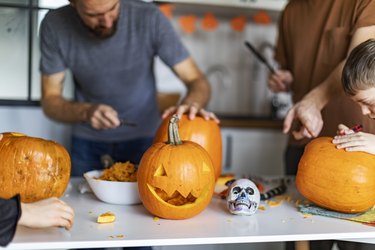
Carving pumpkins for Halloween is so much more fun if you explore ideas beyond the standard jack-o'-lantern face. Shaving or slicing some of the pumpkin skin off and carving the area underneath to various depths allows you to create three-dimensional faces of all sorts, optionally illuminated from within. The variations in thickness results in a play on shadow and light, perfect for just about any character you dream up for your perfect pumpkin.
Why Skin a Halloween Pumpkin?
Video of the Day
Skinning a pumpkin isn't necessary if you're carving holes all the way through, as with the classic jack-o'-lantern. Both replicating an image on a pumpkin and carving a 3D design such as a face with full features requires removing the skin to reveal the pumpkin flesh beneath. Unless you're incorporating the design 360 degrees around the pumpkin, there's no need to remove all the skin.
Video of the Day
Skinning is a bit different than pumpkin carving, so the best pumpkin for the job is one that's relatively smooth and that doesn't have deep ridges. Also pick one with no warts or bumps in the area you plan to skin, as it may be harder to skin those areas with accuracy.
Preparing the Pumpkin
Rinse or wipe the pumpkin off with damp paper towels to remove any dirt and debris on the surface. Removing the inside of the pumpkin is optional, as it depends on your vision for the finished Halloween project. If you're carving a dimensional face, there's no need to remove the pumpkin innards. Either way, set a plastic tablecloth on the table, then set the pumpkin atop it.
If you plan to illuminate your finished DIY design from the inside, remove the pumpkin innards. Use a chef's knife to slice a hole around the top of the pumpkin, about an inch or two away from the stem on all sides, then pull the stem to lift off the pumpkin "lid." Scoop out the inside of the pumpkin, including the pumpkin seeds, using large metal spoons or tools from a pumpkin carving kit.
Save the seeds to toast them later, if you like. Remove any remaining stringy material stuck to the inside of the pumpkin using a melon baller or the edge of a metal spoon. Discard or compost the unneeded innards.
Skinning the Pumpkin for Carving
Choose the smoothest side for your pumpkin design, then remove the pumpkin skin from that area using a clay loop tool, typically used by artists crafting with clay. Some pumpkin carving kits also include such a tool, as it's perfect for removing pumpkin skin. Scrape at the pumpkin surface with this tool to remove strips of it; the process is a lot like peeling a giant potato. Continue shaving away just the very outer layer of the pumpkin skin using the loop tool.
Use a template, if desired, to ensure proper proportions in your finished creation. Hold a paper copy of your image on the pumpkin with strips of masking tape, keeping the paper as close to the pumpkin flesh as possible. Use an awl or the tip of a craft knife to poke holes around the perimeter of all the outlines or key areas of your design, such as the nose, lips and eyes. Remove the tape and paper to reveal small holes that serve as dotted lines to trace for the various areas of your Halloween pumpkin creation.
For a hollow pumpkin, scrape off more flesh from the areas designed to be the lightest, using assorted pumpkin carving tools or a linoleum cutter. Keep the areas meant to be shaded or shadowy intact. If your design is more dimensional, note which areas should stick out the most, such as the tip of a nose, and carve out any areas beneath or around them. It's a bit like carving an image out of a solid block of material, so it's better to remove too little than too much from the various areas since you can always go back and remove more when necessary. Be careful not to carve too deep, which could poke holes all the way through the pumpkin flesh.